- Home
- A. S. Byatt
Peacock & Vine Page 2
Peacock & Vine Read online
Page 2
THE RED HOUSE
The Red House began with images of a staircase tower scribbled in a copy of Murray’s Handbook for Travellers in France when Morris was only twenty-five, on a boat trip on the Seine. The house was designed and built for him in 1859–60 by Philip Webb, whom he had met when studying architecture in the office of the architect of the Law Courts, G. E. Street. It was in the small hamlet of Upton in Kent, in the valley of the River Cray. This very English countryside, green, unremarkable with fields, woods and a river, is reminiscent of Morris’s childhood Essex. There was an orchard of apples and cherries – it is typical of Morris and Webb that they managed to plan the building around the mature trees, leaving almost all of them standing. It is simultaneously imposing and modest, secret and open. It was built in new red brick, which at the time of building would have been a startling scarlet. Pugin had already begun a fashion for using open brick rather than covering it with stucco but the Red House is different from Pugin’s Gothic. It is impressive and spacious but not palatial – it has elements of old barns and farmhouses, but also a certain imposing grandeur. It has steep roofs and Gothic spires, turrets and gables, irregular windows of many sizes, round, square and rectangular, and a formidable well. Morris looked back to the thirteenth century as an ideal age of building and craft, but the Red House is included in Nikolaus Pevsner’s Pioneers of Modern Design as an example of the new and the strongly modern. It is part of its landscape – it had originally gardens enclosed in fences, as Georgiana Burne-Jones remembered, ‘four little square gardens making a big square together, each of the smaller squares having a wattle fence round it with roses growing thickly’.
Credit 2.1
Inside, the spaces are unexpected. There is a dark hall and a twisting staircase but Morris’s studio on the first floor has light on three sides from large windows, and is full of air. The German critic Muthesius described it as ‘the first house to be conceived and built as a unified whole, inside and out, the very first example in the history of the modern house’. Fiona MacCarthy points out that ‘the living spaces flowed from room to room, breaking down the social structures, encouraging less formal male–female relations’. The drawing room was high with exposed beams and a kind of minstrels’ gallery with a door that led into the roof. The room was centred on Webb’s grand, conspicuously plain red-brick fireplace with the motto ARS LONGA, VITA BREVIS. Rossetti had described Morris’s early furniture as ‘intensely mediaeval, like incubi and succubi’. The Red House itself he described as Topsy’s Towers – a mocking reference, perhaps, to Marlowe’s ‘topless towers of Ilium’.
The Red House is both an example of what drew me to Morris – the coming together of life, work and art – and also an example of an attempt to make the kind of community Morris desired – a guild of craftsmen, a fellowship of artists. Rossetti and Lizzie Siddal came there, Edward and Georgiana Burne-Jones, Swinburne the poet and Ford Madox Brown. There was a lot of play – endless games of bowls and competitions of hurling apples. Morris was the host and also the butt of what seem to be incessant japes – his waistcoat sewn up to make him appear even fatter, parcels containing nothing but packing materials, studied refusals to speak to him at the table. Burne-Jones continued to produce brilliant and cruel cartoons. But there was also artistic work – Morris and Jane painted the ceilings, the famous settle imported from the early days of Red Lion Square was decorated with images of Dantis Amor by Rossetti, showing the meetings of Dante and Beatrice on earth and in heaven. Morris left an unfinished painting of Paradise inside the cupboard in the hall – the characters drawn from Malory’s Morte d’Arthur were modelled by Morris’s friends, showing Sir Lancelot bringing Sir Tristram to the Joyous Garde. I find these paintings much less moving and exciting than the unexpected shapes of the house itself. There are paintings on the new plaster where the tempera didn’t hold, depicting a fifteenth-century romance. They have a slightly touching amateurishness out of keeping with the strength of the red brick and the startling angles and lookouts.
Here too is the beginning of Morris’s great work as a fabric designer. It is closely involved with his intelligence as a garden designer. There is an often repeated story of Jane coming home with ‘some indigo-blue dyed serge’ which Morris liked for being everyday. He designed an early version of his ‘Daisy’ pattern and he and Jane embroidered it on the blue cloth. They covered the walls of the bedroom in the Red House with the blue cloth. Morris taught Jane how to embroider. It amazes me how many hands-on techniques of craftwork he mastered – his paintings are stilted but his stitches are full of life, as are his papers and woven cloths. He seems to have learned old embroidery techniques by unpicking existing work. The Morrises’ two daughters, Jenny and May, were born during the years in the Red House, and May was to become a very distinguished embroidress in her own right. There are records of Morris instructing his daughters and workers in the arts – instructions which needed, May said, to be followed very exactly.
Credit 2.2
The garden and the house were one work of art – climbing plants and flowering creepers – white jasmine, honeysuckle and rose climbed the red-brick walls and edged the windows. Morris had strong beliefs about gardens. In a lecture, ‘Making the Best of It’, in 1879 he said:
Large or small [the garden] should look both orderly and rich. It should be well fenced from the outside world. It should by no means imitate either the wilfulness or wildness of nature, but should look like a thing never to be seen except near a house. It should in fact look like part of a house. It follows from this that no private pleasure-garden should be very big, and a public garden should be divided and made to look like so many flower-closes in a meadow, or a wood, or amidst the pavement.
Morris disliked the laid-out Victorian flower beds and the works of the ‘florist’ who bred new flowers to increase the number and size of petals. He also disliked exotic imports – ‘plants which are curiosities only, which Nature meant to be grotesque, and which are generally the growth of hot countries where things sprout over-quick and rank’. He believed in natural materials for fences – ‘when you fence anything in a garden, use a live hedge, or stones set flatwise (as they do in some parts of the Cotswold country), or timber, or wattle, or in short anything but iron’. The flowers he loved were the English countryside flowers – briar roses, violets, poppies, sunflowers, dog roses, snowdrops, single snowdrops, simple bluebells, wild honeysuckle, single sunflowers. He wrote of the sunflower:
the double sunflower…is a coarse coloured and dull plant, whereas the single one…is both interesting and beautiful, with its sharply chiselled yellow florets relieved by the quaintly patterned sad-coloured centre clogged with honey and beset with bees and butterflies.
Credit 2.3
As this shows, he understood the flowers in many ways, and his patterns for wallpapers and woven cloths startle us into a new understanding of their forms. His first wallpaper design, done in 1864, shows single roses climbing up a trellis with busy insects and hummingbirds drawn by Philip Webb. His understanding of the relation between the repeating geometry of the regular trellis and the moving, growing geometry of the plant forms, in and out of the trellis squares made endlessly varied patterns available to him.
Credit 2.4
The work on the Red House led to the formation of a craft cooperative which, in 1861, became Morris, Marshall, Faulkner & Company, with its first workshops and offices in Red Lion Square. This became known as The Firm. They made beautiful things – furniture, stained glass, fabrics, wallpapers, painted tiles and embroidery. Morris never solved the problem of costs – the things The Firm made needed moneyed buyers as the materials were not cheap and the craftsmanship took time. Morris and Webb were at the centre – Rossetti and Burne-Jones joined in, the latter becoming a master of stained-glass design.
For two or three years they worked in Red Lion Square and travelled out to the Red House at weekends, where they were met by a covered cart specially designed by Webb. Morris h
oped that the community would live there together. But in early 1862, Rossetti’s wife, Lizzie Siddal, died, and two years later, when he was making plans for the Burne-Joneses to move in, Georgiana became seriously ill after the death of her premature son. Morris himself became ill and in the summer of 1865 The Firm took on a lease of larger premises in Queen Square in Bloomsbury. The Morris family moved into a flat above the Queen Square workshops. Morris could never bear to go back to the Red House, which was sold. Many of the objects were dispersed – some went to Kelmscott Manor, some to the Victoria and Albert Museum. The Red House became a private home, but now belongs to the National Trust which hopes to reassemble some of the objects and recreate the garden as far as it can. It is researching the wall hangings in the hope of restoring them too.
—
When I was a small child I learned Morris’s poem:
I know a little garden-close
Set thick with lily and red rose,
Where I would wander if I might
From dewy morn to dewy night,
And have one with me wandering.
And though within it no birds sing,
And though no pillared house is there,
And though the apple-boughs are bare
Of fruit and blossom, would to God
Her feet upon the green grass trod,
And I beheld them as before…
As long as I had known about the Red House I had a mental image of the house, the garden, and the countryside with fields, hedges and river. We went there to visit, only to find that the solid edges of urban London have surrounded and almost swallowed it. The enclosed garden is defensive in a way it was not when it was made. It is outside its time, and very moving.
KELMSCOTT MANOR
In June 1871 Morris and Rossetti took Kelmscott Manor near Lechlade in Gloucestershire on a joint lease. Morris wrote to his friend Charley Faulkner:
whither do you guess my eye is turned now? Kelmscott, a little village about two miles above Radcott Bridge – a heaven on earth; an old stone Elizabethan house like Water Eaton, and such a garden! close down on the river, a boat house and all things handy.
Morris loved the house because of its simplicity – he described it as ‘a beautiful and strangely naïf house’ and wrote of it as:
a house that I love; with a reasonable love I think…so much has the old house grown out of the soil and the lives of those that lived on it: needing no grand office architect…but some thin thread of tradition, a half-anxious sense of the delight of meadow and acre and wood and river…a liking for making materials serve one’s turn.
He wrote also:
The land is a little land…all is measured, mingled, varied, gliding easily one thing into another: little rivers, little plains, swelling speedily changing uplands, all beset with handsome orderly trees…all is little; yet not foolish and blank, but serious rather, and abundant of meaning for such as choose to seek it: it is neither prison nor palace but a decent home.
Morris loved the gabled grey-stone building, made, Fiona MacCarthy tells us, from the coarse local oolite stone of the Thames Valley – he loved ‘the entrances and exits, surprise views, odd heights and depths and juggling with spaces’. ‘What gave him great delight was the way in which the slates had been “sized down” by the roofers, so that they used the small ones at the top, graduating to larger ones down towards the eaves. The “ordered beauty” of the Kelmscott roofs reminded him of birds’ feathers, fishes’ scales.’
Morris had said he was looking for a ‘house for the wife and kids…a little house deep in the country where she and the children are to spend some months each year.’ But, as later writers have pointed out, he was perhaps also trying to find somewhere where the relations between Rossetti and Janey would be less visible. What in fact happened was that Rossetti settled into Kelmscott Manor and Morris – after his first trip to Iceland in the summer of 1871 – felt himself unable to go there. It was clearly unbelievably painful. By September 1872 Rossetti was talking about settling permanently in Kelmscott. Morris finally admitted in an unusual outburst in a letter:
another quite selfish business is that Rossetti has set himself down at Kelmscott as if he never meant to go away; and not only does that keep me away from that harbour of refuge (because it is really a farce our meeting when we can help it) but also he has all sorts of ways so unsympathetic with the sweet simple old place, that I feel his presence there as a kind of slur on it: this very unreasonable though when one thinks why one took the place, and how this year it has really answered that purpose: nor do I think I should feel like this about it if he had not been so unromantically discontented with it and the whole thing which made me very angry and disappointed.
Credit 2.5
Rossetti in his early days at Kelmscott wrote of his pleasure in long walks with Mrs Morris, whom he painted in The Water Willow in 1871, holding branches of willow beside the water, with the River Thames and the gables of Kelmscott in the background. He invited friends and models to visit, and also painted, obsessively, several versions of Jane as Proserpine – with clinging ivy. He painted a total of fifty-seven studies of her, the best done at Kelmscott. But he was addicted to chloral and whisky, and did not like being left in Kelmscott when Jane and the children were with Morris. In June 1872 he had a breakdown and in 1874, after Morris had reorganised his business, cutting Rossetti out of the company, he abruptly left. Morris was able to return to his house, his favourite retreat from work in Queen Square.
Credit 2.6
Life in Kelmscott Manor was austere – there were three adjacent outdoor privies, that can still be seen, and no running water. Guests such as George Bernard Shaw found the water frozen in the glass by their bedside. Charles M. Gere made the iconic woodcut of Kelmscott Manor which was used in Morris’s News from Nowhere – an image of the main front of the manor with the path, flanked by standard roses, leading up to the entrance door, plants growing up the stone walls and a flock of birds in the sky. He recalled staying at Kelmscott Manor ‘in a small room adjoining Morris’s study, where he could be heard writing with quill pens which he threw down as they blunted’. He wrote:
At Kelmscott manor I stayed in a little powder closet which opens from the Tapestry Room. [This contained some original tapestries of the tale of Samson and Delilah, dating from 1600.] Morris used to bring me in a can of hot water in the morning. He used to tumble out of bed, have his tub, slip into his blue shirt and blue suit, thrust a brush – or maybe only his hands – through his curly hair and beard – all the work of a few moments – and he was ready for the day’s adventure.
Morris liked everything solid and large; the washbasins and jugs were of massive proportions in earthenware; his teacup and porridge bowl the same. He liked his bread in solid chunks; on one occasion Gere cut some bread at breakfast far too thin for his taste. A moment later he arrived and with a shout of disgust roared out, ‘Who cut this bread?’ Walks with Morris around the country were always a treat and an education. It was on one of these walks that he said, ‘You must enjoy a work of art in your stomach.’
Morris loved the River Thames, and all through his life lived or worked close to it. May Morris, his daughter, in her biography of her father, recalls him talking to her about the willows on the banks, and teaching her to see their structures. ‘He noted every turn of a leaf or attachment of a stem, watched every bird on the wing with keen alert eye: nothing in the open air escaped him.’
He was interested in structure, not symbolism. Rossetti’s Water Willow perhaps shows the usual sadness of ‘weeping willow’. Morris’s wallpaper, Willow, is a masterpiece of observation, both of geometry and of the real shapes and forms of growing plants. As May said, ‘Without being a “symbol” of any special thought, each of the more important patterns for papers or chintz had its mark, its standing or its bit of story’. Morris’s chintzes of the mid-1870s – such as Honeysuckle, Iris and Marigold – were made after hours of sketching and study. He was already lear
ning to make vegetable dyes from roots, flowers and the willow twigs themselves – another passion he shared with Fortuny.
And he listened to all the birds. Birds on roofs, birds in trees, birds in and on water. In the late summer of 1871 he wrote:

 The Children's Book
The Children's Book Babel Tower
Babel Tower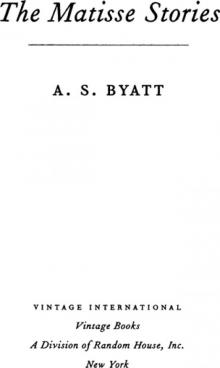 The Matisse Stories
The Matisse Stories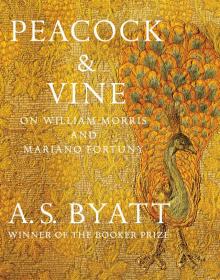 Peacock & Vine: On William Morris and Mariano Fortuny
Peacock & Vine: On William Morris and Mariano Fortuny Elementals: Stories of Fire and Ice
Elementals: Stories of Fire and Ice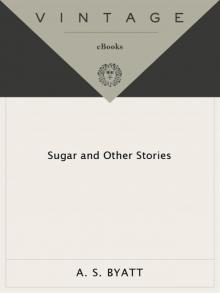 Sugar and Other Stories
Sugar and Other Stories Possession
Possession Little Black Book of Stories
Little Black Book of Stories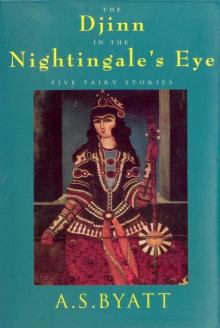 The Djinn in the Nightingale's Eye
The Djinn in the Nightingale's Eye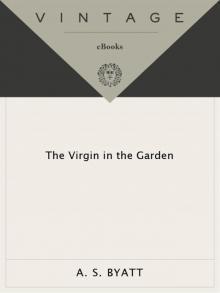 The Virgin in the Garden
The Virgin in the Garden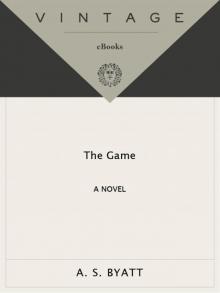 The Game
The Game The Biographer's Tale
The Biographer's Tale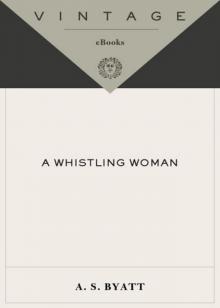 A Whistling Woman
A Whistling Woman Ragnarok
Ragnarok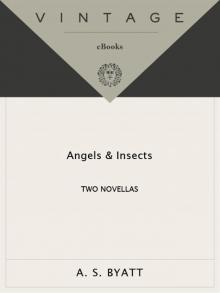 Angels & Insects: Two Novellas
Angels & Insects: Two Novellas Ragnarok: the End of the Gods (Myths)
Ragnarok: the End of the Gods (Myths) Peacock & Vine
Peacock & Vine The Djinn in the Nightingale's Eye (Vintage International)
The Djinn in the Nightingale's Eye (Vintage International)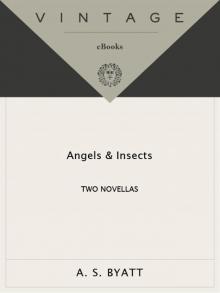 Angels and Insects
Angels and Insects The Arabian Nights: Tales from a Thousand and One Nights (Modern Library Classics)
The Arabian Nights: Tales from a Thousand and One Nights (Modern Library Classics) Elementals
Elementals